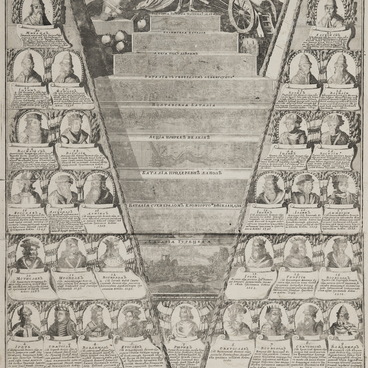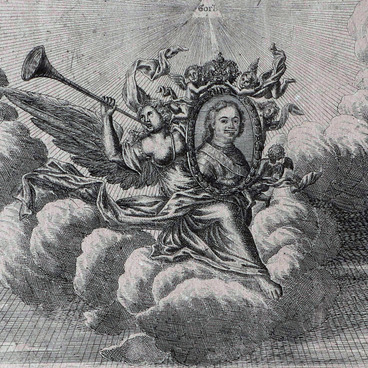A special type of portrait of the monarch is attributed to the period of the Great Embassy. This is a half-length portrait of Peter I in traditional attire of the Russian sovereign: a fur cap with diamond plaques, a Moscow-style caftan with loops sewn to the outside and a brocade fur coat with a fur collar draped over the shoulders. The plaques on the cap, the fur coat and the loops on the kaftan are decorated with pearls. Art historians note that the pearl plaque from Peter’s cap can also be seen on the portrait of tsar Alexis. This plaque is considered to be one of the royal family’s jewels.
Little is known about the maker of this engraving. Jacob Gole (1660–1737) was a Dutch draftsman and engraver. He lived in Amsterdam and worked in the mezzotint technique. He was also a publisher. He was known for making portraits of famous people such as Pope Innocent XI, Louis XIV and Philippe I Duke of Orléans.
However, the history of the engraving itself is more interesting. There are three known distinct prints made with it. The first one was based on an original portrait created by an unknown artist before 1697. It depicts a young man with an elongated oval face, a long nose and small eyes. His appearance is far removed from the traditional depictions of the first Russian emperor. Nevertheless, the art critic Dmitry Rovinsky attributed the sheet to the section “Portraits [of Peter I] of unknown origin”.
This first version was engraved by Jacob Gole and Robert White (1645–1703). Probably, due to the lack of portrait similarity, few copies were made, thus it became a rarity, which by the time of the 19th century made it highly valuable. Rovinsky also wrote about this.
In September 1697, Godfrey Kneller painted Peter’s portrait. Kneller’s portrait on the contrary achieved a great portrait resemblance to the young tsar. And so, Jacob Gole scraped off the unsuccessful fragment from the first print, made a new panel. The print had a new face from Kneller’s original, while at the same time keeping the background, costume, accessories and signatures.
Finally, there is a third rough print: it is noticeable that the entire plate was retouched one too many times, the contours were re-traced with a needle and there are spots left by the scraper in the upper right part of the sheet.


